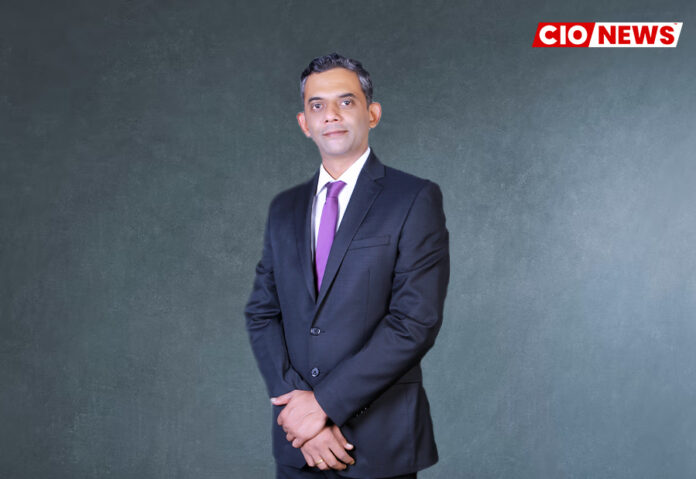
Any banking mechanism strives to enhance the customer experience. A unified tool takes this one step further by allowing customers to carry out various financial operations on the same platform.
This is an exclusive article series conducted by Santosh Vaswani, Editor at CIO News with Mr. Praveen Paulose, MD & CEO of Celusion Technologies.
About Praveen Paulose:
Praveen Paulose is the MD & CEO of Celusion Technologies. His primary focus is to build a culture of innovation and a supportive environment for technology enthusiasts to solve real-world problems. He believes there is no greater joy than seeing people use and benefit from the technology built by Celusion. Praveen is a software architect, product manager, and hands-on developer with an entrepreneurial spirit. He believes in working towards the future use of technology, addressing new problem statements in new target markets, and innovating through his journey. He aspires to be an investor someday, where he can share his life experiences and help other businesses work under diverse work paradigms with a diverse workforce, creating impactful results overall.
Benefits of using a unified banking mechanism to offer a gamut of services
A unified banking mechanism integrates various banking services into a streamlined operational framework. The implications of such a framework entail easy accessibility for multiple services within a single application for customers. Consolidating different systems, processes, and data within a single framework creates a more efficient and customer-centric approach. This significantly aids the customization of consumer interests through various services via its essential aspects. The first of these aspects is the unified mechanism that integrates multiple systems and platforms. Financial institutions use these systems and platforms to enable various functions. These functions include customer relationship management, core banking, risk management, and more. The integration of these systems and platforms helps in real-time data sharing. Another important feature is data centralization, one of the most fundamental aspects of a unified mechanism. Centralization provides a consolidated overview of customer profiles, including different types of data such as transactions, accounts, customer interactions, etc. This gives organisations a repository of information to study, which can help them create personalised services for their customers.
Personalising and enhancing customer experiences
Any banking mechanism strives to enhance the customer experience. A unified tool takes this one step further by allowing customers to carry out various financial operations on the same platform. Moreover, customers can also get more personalised services from financial institutions that provide tailored experiences based on their application use and choice of services. This can happen because organisations can access customer information, predict and address their grievances, and provide customer-centric solutions accordingly.
Features in the unified banking system
A unified system has a high level of security built in. With a centralised system for data management combined with access controls, banks can better protect customer information while ensuring compliance with regulatory requirements. With every operation being standardised in a unified mechanism, banks can collate data analytics and customer feedback in one place. This helps them refine their services, adapt to evolving customer interests, and identify gaps in their offerings. Banks can also allocate more resources towards the ongoing customization and optimisation of customer services. The integration of systems into a unified mechanism leads to a reduction in operational costs for banks and financial institutions. The result of this is an increase in profitability. Banks can also expand their operations and customer base to accommodate growth ambitions. This is made possible because of the scalable nature of unified mechanisms.
Examples to substantiate the functioning of the unified banking system
The best example of a unified banking mechanism is India’s most significant financial success story: the United Payments Interface, or UPI. UPI has played a critical role in modernising and simplifying financial transactions for Indians. By connecting multiple financial institutions to a single platform, the application facilitates seamless transactions for customers. Customers can link more than one bank account to their UPI ID, meaning they don’t require separate applications for each bank account. A centralised interface also means customers can initiate various transactions on the same platform. From bill payments to personal transfers, it’s all possible in one place. UPI facilitates real-time financial transactions, allowing customers to carry out their activities in seconds. All it takes is a single scan of a QR code, selecting a number in their contact list, or just tapping the icon of a financial institution to facilitate a recurring payment. UPI also allows for the integration of third-party applications known as payment service providers (PSPs). This gives the platform additional features and services. It also creates a unified ecosystem for customers to access different financial services with the same UPI ID. All of these features on a single platform raise the question of security for consumers, which is put to rest with the stringent measures put forward by UPI. A multi-factor authentication and end-to-end encryption system protects anyone other than the original user from carrying out any unauthorised transactions. The National Payments Corporation of India regulates the security infrastructure and has complete oversight over the system. Furthermore, standardised protocols and regulatory guidelines are implemented to give users a secure experience, no matter what service, bank, or transaction they use. UPI is an excellent demonstration of a unified mechanism in banking operations that empowers customers by catering to their interests across various services. Any unified system would emulate UPI’s infrastructure to simplify financial transactions, strengthen data security, and give users a single point of access for all their banking needs.
Do Follow: CIO News LinkedIn Account | CIO News Facebook | CIO News Youtube | CIO News Twitter
About us:
CIO News, a proprietary of Mercadeo, produces award-winning content and resources for IT leaders across any industry through print articles and recorded video interviews on topics in the technology sector such as Digital Transformation, Artificial Intelligence (AI), Machine Learning (ML), Cloud, Robotics, Cyber-security, Data, Analytics, SOC, SASE, among other technology topics.





